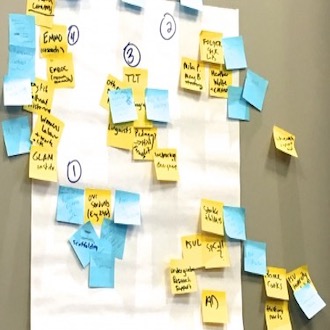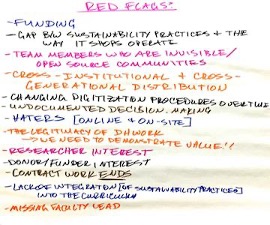A book can have a long life.
On a desk, on a shelf, in a bin, on a rack, or in a dusty basement corner of a library, a book, once published, can hibernate for years and decades, even centuries, because it has physical properties giving it material existence.

But what about a digital book? How long does it last? More to the point, how long can it last?
Digital artifacts, unlike print materials or books, often seem to appear out of nowhere and disappear. Unlike books, digital creations have virtual lives, and that means, as scholars and creators, we need to plan to make them stay alive, so to speak. And in case we want to see them off into the good night, we can plan for that, too. But how?
These issues formed the central focus of Sustaining DH: An NEH Institute for Advanced Topics in the Digital Humanities, which was held at Brown University, Providence, Rhode Island, on April 4-5, 2019. It was led by Professors Alison Langmead, Chelsea Gunn, and Aisling Quigley from the Visual Media Workshop at the University of Pittsburgh.

The two-day intensive sessions involved presentations by Professor Alison Langmead about re-thinking sustainability in relation to digital projects; she led several workshop modules, each building on the previous one, organized around core principles of sustainably: duration of the project before and after completion; project’s priorities and key participants; staffing and technologies; technological infrastructure; accessing and backing up the project; file formats and metadata; permissions and data integrity; and a digital sustainability plan. These rubrics are drawn directly from the Socio-Technical Sustainability Road Map, which was developed by this team of researchers.
Professor John Muthyala, who leads USM Digital Humanities, was invited to attend the Institute, along with Jennifer Keplinger, Learning Designer at the Center for Technology-Enhanced Learning.
Jennifer Keplinger noted, “The Socio-Technical Sustainability Road Map is a guiding framework for not only faculty and staff who are undertaking research projects, but also students who are completing project-based assignments. I look forward to finding creative ways to integrate it into USM classes.”

During the sessions, Muthyala and Keplinger made copious notes and completed Excel spreadsheet assignments, which they found immensely helpful, as they are collaborating on a digital humanities project that aims to use digital tools creatively to advocate for the arts and humanities in higher education and civic life.

“Thinking about the life of the project and planning for it, right at the outset,” observed John Muthyala, “was helpful, because with digital technologies, a new set of ideas and practices come into play. At USM, as part of the USM Digital Humanities initiative, we hope to start important institutional conversations leading to practical, comprehensive policies to help faculty, staff, and administrators review and evaluate digital scholarship and creativity.”
“Thinking about the life of the project and planning ahead was helpful, because with digital technologies, a new set of ideas and practices come into play. At USM, as part of the USM Digital Humanities initiative, we hope to start important institutional conversations leading to practical, comprehensive policies to help faculty, staff, and administrators review and evaluate digital scholarship and creativity.”
– John Muthyala, Professor, Department of English

